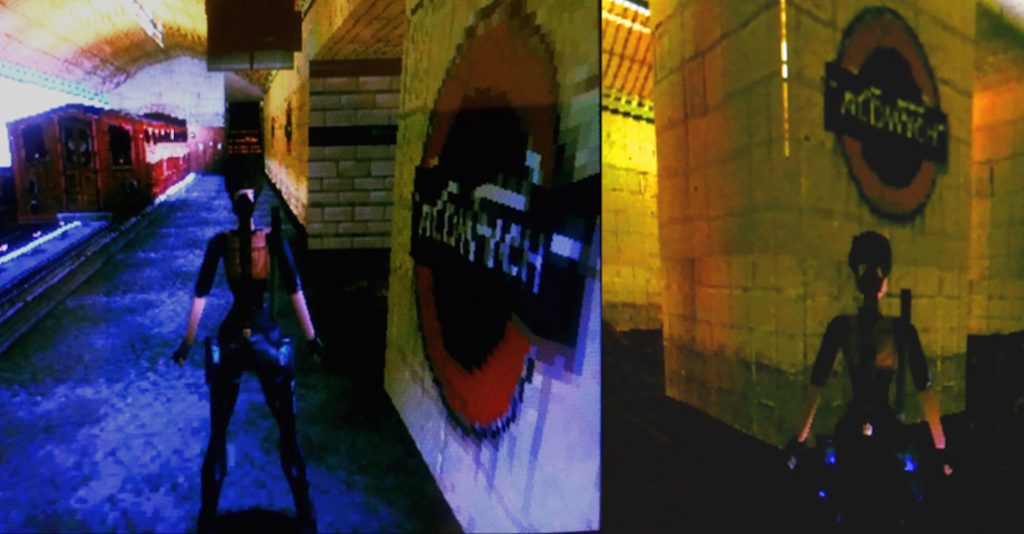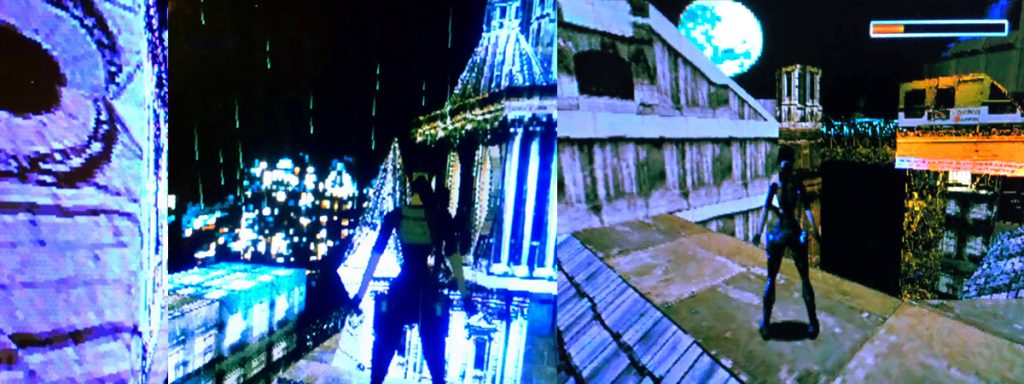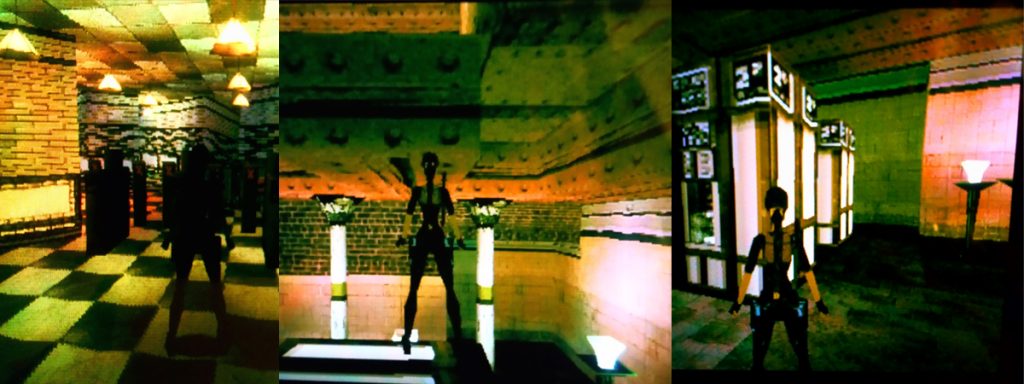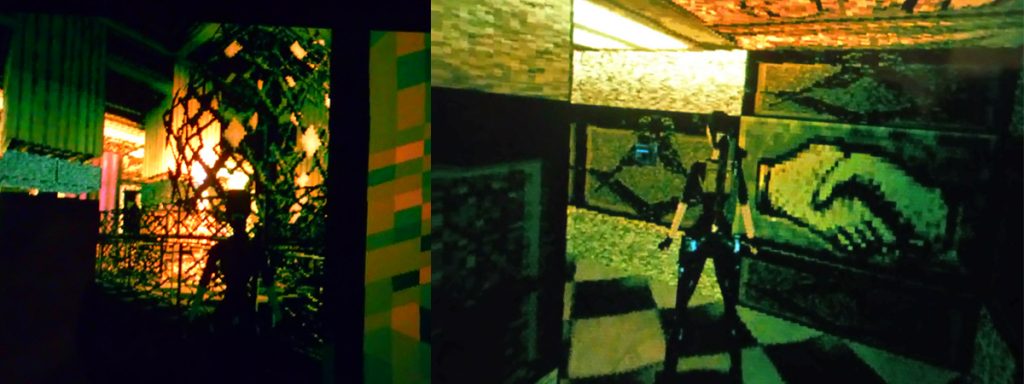Life (and Death) beneath the Virtual Strand
Posted in 1990-1999, 20th Century, churches, entertainment, Places, Transport, underground and tagged with Aldwych, cinema, Elgin marbles, freemasonry, psychogeography, Tomb Raider, transport, underground, videogames

Since its retirement from public service in 1994 Aldwych tube station (née Strand) has been busily pursuing a second career in showbusiness. Scoring a part in The Prodigy’s ‘Firestarter’ video (1996) before going on to star in films like V for Vendetta (2005), Atonement (2007) and Fast and Furious 6 (2013), it’s also broken into interactive entertainment, featuring prominently in Tomb Raider III (1998). With the game’s twentieth anniversary looming, it felt like as good a time as any to explore this digital recreation of Aldwych, and to consider how it has become bound up with the biographies of game designers like Andy Sandham and fans like Ash Kapriolev – whose recent interviews with Sandham offer, amidst all the ludophile trivia, some intriguing insights into the Strand’s role in the popular imaginary and the developing relationship between real spaces and their virtual versionings.
From Atlantis to Aldwych
As anyone who remembers the 1990s will know, the Tomb Raider series became famous – or perhaps notorious – for its protagonist Lara Croft, a kind of leotard-clad Indiana Jones for the Girl Power era. In the wake of the first game’s phenomenal success, publishers Eidos went to increasingly tawdry lengths to market Lara as a CGI sex symbol, while early videogame scholars placed her at the centre of debates about agency, interaction and objectification, representation and simulation. Revisiting Tomb Raider (1996) today, it’s rather difficult to imagine anyone getting hot under the collar at the sight of a player-character who looks so much like a Modigliani made out of Toblerone boxes. It’s also bracing to discover how tricky the leaden-yet-finicky Lara (whose debut predated the advent of analogue controllers calibrated for 3D gameplay) can be to manoeuvre. It’s still easy, however, to see why so many people – my thirteen-year-old self very much included – got a kick out of exploring what were, at the time, unprecedentedly expansive and atmospheric virtual spaces.
Created by six members of Derby-based studio Core Design, that first game took players on a globetrotting archaeological expedition encompassing Incan villages, Roman catacombs, Egyptian pyramids and, climactically, the lost city of Atlantis. While it might seem ironic that Core would choose to set a (then) cutting edge game amidst the ruins of ancient civilisations, from a technical perspective it was an ingenious decision. As the screenshots peppering this article attest, the limited geometry budgets and low resolutions mandated by mid-90s hardware meant early 3D games were necessarily going to look jagged and blocky – so why not choose a setting full of pyramids and obelisks, ziggurats and mosaics?
By Tomb Raider II (1997), however, Lara was taking her first steps out of antiquity and into the (early) modern environment of Venice, and for the third game in the series Core decided to include an episode set in contemporary London. Taking in St. Paul’s cathedral, Aldwych station, a subterranean Masonic temple (presumably supposed to lie beneath the Grand Lodge on Great Queen street, the history of which you’ll find detailed in a Strandlines post by Susan Snell) and the British Museum’s Egyptology section (cue droll allusions to the original Tomb Raider‘s Egypt levels), the sequence ends with a boss battle atop Richard Rogers’ Lloyd’s building, then twelve years old.
An Archaeology of the Virtual City
Within a few years games like Metropolis Street Racer (2000) and The Getaway (2002) would be taking advantage of more powerful hardware to present (fairly) faithful recreations of central London. In 2001 the enormously successful Grand Theft Auto III would inaugurate the ‘open world’ genre by giving players an entire 3D city to roam, establishing a template that games like 2015’s Assassin’s Creed Syndicate (which contains a recreation of the Strand circa 1868) continue to follow. Meanwhile, videogame studios would swell from handfuls to tens to hundreds, as production budgets skyrocketed (Yu Suzuki’s’s Shenmue games (1999, 2000), which featured a meticulously detailed recreation of 1980s Hong Kong, reportedly cost tens of millions of dollars, bringing Sega to the brink of financial collapse).
By comparison with these games, Tomb Raider III’s take on London is crude and quaint – but also impressively ambitious. While by 1998 the studio’s tech had been retooled so that Core’s environmental artists could incorporate coloured lighting and more organic shapes into their designs, the ageing PlayStation hardware still placed considerable constraints on what was possible. These constraints become apparent as soon as the system loads the first London level, which begins with Lara looking out across the rooftops towards what’s supposed to be St. Paul’s. Rendered here in what Sandham, lead designer for the episode, describes as ‘accidentally “cubic’’’ form, its ‘dome’ nowhere near hemispherical, the cathedral is all-but unrecognisable.[i]

Lara on and around St. Paul’s cathedral, with its angular ‘dome.’
While a degree of abstraction was unavoidable here, in other respects the team strove for realism, with Sandham ‘spen[ding] many hours (like a loon) working out the actual geography of the level[s]’, determined that Lara’s route through London ‘should all actually, physically, make sense’, taking her from the Thames via Fleet Street to the disused Underground tunnels that Sandham had ascertained ‘align underneath the British Museum’ – which, as a kind of contemporary ruined labyrinth (not to mention the site where the Elgin Marbles waited out the Blitz) turns out to be an ideal setting for a Tomb Raider level.[ii]
In the interviews Sandham justifies this ‘obsess[ion] with geographical accuracy’ and with ‘mak[ing] sure the locations were all plausible and “reachable” from one another’ by arguing that such details enhance ‘player immersion’ – a rationale that ignores the many, many ways in which the Tomb Raider games defy plausibility.[iii] As Alexander Galloway has argued, videogames generally are more concerned with ‘realisticness’ than realism per se, and for all Sandham’s efforts Tomb Raider III’s ‘London’ still feels very much like a suite of videogame levels, haunted as they are by gun-toting henchmen and mutated thugs looking for magical artefacts. ‘Aldwych’ is less an approximation of an actual space than it is an ingeniously configured obstacle course, riddled with secret passageways, puzzles and devious traps.
Like all Tomb Raider levels, this structure begs to be ‘read’ in relation to Lara’s rigidly codified repertoire of moves (jump, grab, shimmy, sidestep, backflip, sprint, hop etcetera), calling on players to work out the string of actions necessary to reach, say, that ledge up there – which often entails Lara dying repeatedly as we test hypotheses. Objects must be found and deployed, switches thrown and levers pulled in sequences that are often Rube Goldberg-like in their intricacy – to escape Aldwych, for example, we have to find the maintenance room key so that we can restart the generator so that the vending machine will eject the old penny so we can buy a ticket from the ticket machine so we can pass through the barrier, and so on.

Ticket barriers and ticket machines. Note barely legible price of 2d (not, in fact, the cost of a travelcard in 1994), and how the aggressively compressed textures create pixelated patterns within patterns on the tiled floors and walls…
Sites of Production (of Sites)
In a sense the ‘London-ness’ of this space is no more than skin deep; on a computational level these are wireframe meshes made up of tessellated polygons that then have 2D ‘texture maps’ pasted on top of them. By applying a different texture map to the same object designers can make it look like it’s made out of sandstone or marble, bark or flesh. Swap out the textures used to decorate Aldwych station for those used in Tomb Raider’s Roman levels and the space would start to look more like a cavernous mausoleum than a tube station. And yet these textures are also, in some cases, traces of the design team’s actual journeys through the city; Sandham jokes that the project ‘allowed me a lot of “research time” in London, if that’s the right phrase. I still recall standing in tube stations with my breeze block sized digital camera taking photographs of the floor and walls for textures!’[iv]
Another post on Kaprielov’s site, documenting his pilgrimage to Aldwych, juxtaposes photos of the station with screengrabs of the game, highlighting a number of places where objects photographed by Sandham made it into the gameworld while also noting instances of poetic license (like the replacement of Aldwych’s spiral staircase with the kind of brushed steel escalators more commonly found in contemporary tube stations).[v] The interplay of real and virtual becomes complex here, as the fan retraces the avatar’s journey through the virtual version of a space actually documented by the designer – the kind of knotty spatiotemporal relationship that has spawned a subdiscipline of ‘archaeogaming’ studies.
Kapriolev’s interviews with Sandham suggest how the internet has transformed the terms on which images circulate and spaces are mediated. Describing the design of Tomb Raider 4’s Egyptian levels, Sandham notes ‘we all spent a lot of time in the British museum, and trawling around the bookstores on the street opposite for the books with the most photographs of textures in! It was always a highly sought after prize – the book with the most textures that we could scan in. (I should point out the internet was still relatively useless with regards resources at this point)’.[vi]
If Sandham’s blasé attitude to copyright here echoes Lara’s blithe disregard for the rightful owners of the treasures she loots, it also speaks to Core’s punishing production schedule, which saw the studio making five Tomb Raider games in five years at the behest of a publisher desperate to capitalise on the franchise’s popularity. Tomb Raider III’s British Museum wasn’t just an alibi for cute callbacks to older games; it also meant Sandham could ‘re-use some of Toby [Gard, Tomb Raider graphic artist and lead designer’s] original textures to save meself some bother’. These textures appeared alongside others drawn from trips to Bloomsbury, where ‘the team spent 2 days… taking photos of [the British Museum’s Egyptology section’s] floors and walls (instead of the actual exhibits) with our antiquated digital cameras.’[vii] Today, the (routinely underemunerated) labour of creating ‘art assets’ for blockbuster games is frequently farmed out to subcontractors and satellite studios, often located in the same parts of the world Lara once combed for priceless archaeological treasures.
Lore and Orders

The game’s Masonic temple
According to Sandham, Tomb Raider III’s representation of the subterranean Strand reflects his interest in abandoned tube stations and his ambition ‘to try and get in as much “London lore” as possible’ – an ambition he invokes to explain the inclusion of the Masonic temple.[viii] While he doesn’t specify any sources or inspirations, there’s something very psychogeographical about Tomb Raider III. The name of the level Lud’s Gate recalls Ian Sinclair’s Lud Heat: A Book of Dead Hamlets (1975), while the Aldwych temple is a striking inclusion in a game released in the same year as the final volume of Alan Moore and Eddie Campbell’s From Hell (1989-1998), which drew on Sinclair, Peter Ackroyd and the more esoteric corners of Ripperology to give an account of the Whitechapel murders in which the killings are bound up with Masonic skullduggery and St. Paul’s occupies the centre of a giant pentagram. Less erudite than the psychogeographical canon – but also less ghoulishly macabre – Tomb Raider III participates nevertheless in modes of imagining London that were, for better or worse, attaining broader pop cultural purchase at the time.
Having never played Tomb Raider III before this autumn (an exclusivity deal brokered after the first game became a hit meant its sequels were never ported to the platform I owned back then), I’ve found the experience of plugging through it on a spate of recent flights and coach rides rather eerie; it’s an old game that’s new to me while also being a sequel to a longstanding favourite of mine; it’s also a game that transplants a character associated with ancient tombs to a stretch of modern London I’ve come to know well. The experience of playing a downloadable version on the move started to seem, at least to my jetlag-addled mind, emblematic of the broader interplay of novelty and nostalgia, mobility and stasis in digital pop culture. If nothing else, the game constitutes another strange chapter in the Strand’s history, a history that has seen Aldwych become noteworthy not just as an example of Edwardian transport infrastructure, a makeshift bomb shelter or the erstwhile address of some bits of the Parthenon, but as the inspiration for a space some gamers have spent decades exploring too.
[i] http://tomb-of-ash.tumblr.com/post/94071931125/interview-with-andy-sandham-part-ii
[ii] http://tomb-of-ash.tumblr.com/post/138947891815/your-ultimate-guide-to-the-real-locations-in-tomb
[iii] http://tomb-of-ash.tumblr.com/post/94071931125/interview-with-andy-sandham-part-ii
[iv] http://tomb-of-ash.tumblr.com/post/93095805215/interview-with-andy-sandham-core-design
[v] http://tomb-of-ash.tumblr.com/post/130331437730/exploring-aldwych-the-real-location-from-tomb
[vi] http://tomb-of-ash.tumblr.com/post/93095805215/interview-with-andy-sandham-core-design
[vii] http://tomb-of-ash.tumblr.com/post/138947891815/your-ultimate-guide-to-the-real-locations-in-tomb
[viii] http://tomb-of-ash.tumblr.com/post/94071931125/interview-with-andy-sandham-part-ii

